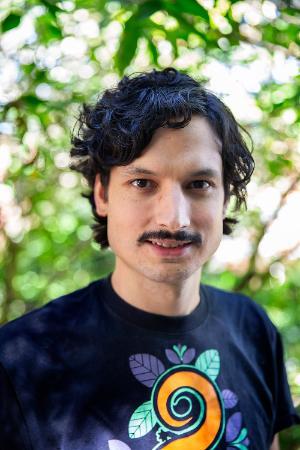About
I am a postdoctoral associate working in an NSF-funded project that is examining the distribution of both asexual and sexual stages of macrofungi across the United States. I completed my doctorate in fungal biology in the lab of Dr. Matthew Smith at UF. From August 2021 to September 2023, I was a postdoctoral researcher studying the response of microbial communities to wildfires with Dr. Sydney Glassman at the University of California Riverside (UCR).
-
Education
- Ph.D. Plant Pathology, University of Florida, 2021
- M.Sc., Instituto de Ecología A.C., 2016
- Bachelor’s in environmental sciences, Universidad de Chile, 2013
-
Research
My research interests are fungal ecology, evolution and systematics and community ecology. I use a combination of molecular, morphological and culture-based methods. My main research interests are:
• Dispersal and population biology of ectomycorrhizal fungi
Most ectomycorrhizal fungi produce fruiting bodies to disperse their spores. Some fungi produce fruiting bodies above ground (mushrooms) that shoot their spores into the air and rely on wind for dispersal. In contrast, others produce enclosed below ground fruiting bodies (truffles) and rely on animals to disperse their spores. Although the dispersal of truffle-like fungi by mammals has been extensively studied in Europe, North America and Australia, the role of non-mammalian dispersers such as birds remains poorly understood. In my dissertation, I documented the role of two native Patagonian birds Chucao Tapaculo (Scelorchilus rubecula) and Black-throated Huet-huet (Pteroptochos tarnii) in the spore dispersal of native fungi, including truffle-like fungi and other ECM fungi. I used a combination of amplicon sequencing to detect the wide diversity of mycorrhizal fungi and truffles consumed by the birds and epifluorescence microscopy to assess the integrity of the spores (as a proxy of viability) that passed through the digestive system of the birds. This is one of the first well documented systems where bird mycophagy is an important dispersal mechanism for mycorrhizal fungi and truffles. This project was funded by a National Geographic Explorer grant, in collaboration with Dr. Matthew Smith and Dr. Michelle Jusino. The results of this study were published in the journal Current Biology (Caiafa et al. 2021).
• Systematics and evolution of truffle-like fungi
Truffles form enclosed fruiting bodies that are unable to forcibly discharge spores. Truffles are an important source of food for many vertebrates and play critical roles ecosystem as plant symbionts (ectomycorrhizae). Their tough spores make them important components of spore banks and their association with animals make them more likely to have long-distance dispersal events. Truffle morphology has evolved independently in more than 60 fungal lineages, making them a unique group to study the evolution of complex fruiting bodies. I have documented the diversity and phylogenetic relationships of truffle-like fungi associated with Nothofagaceae forest in southern South America. I documented the wide diversity of truffle-like species of Inocybe from Nothofagaceae forests (Caiafa et al. 2021, Mycologia). This study provided new insights about the ecology and evolution of this group where truffle-like forms are extremely rare or nonexistent. I have also collaborated in several systematic studies of southern South American fungi, including a taxonomic and phylogenetic overview of truffle-like fungi in the genus Cortinarius (Nouhra et al. 2021) and a re-examination of the truffle genus Amylascus that was believed to only occur in Australia and the discovery of the new genus Nothoamylascus (Healy, at al. 2023).
• Ecology and evolution of fungi with uncertain trophic modes
Most ecological models assume that species have only one trophic mode. While this is true for the vast majority of plants and animals, many fungi defeat that assumption. For example, some fungal pathogens can behave as pathogen in the presence of the host but survive as a free-living saprobe when host dies. Early diverging Boletaceae are an interesting group to study fungi with uncertain trophic modes. While the majority of Boletaceae species are ectomycorrhizal, the biology of two clades, Pseudoboletus and Chalciporoideae, is less clear. I studied the ecology, evolution, and trophic mode of early-divergent Boletaceae, particularly the genus Buchwaldoboletus (Chalciporoideae). Species in the genus Buchwaldoboletus are known to fruit directly on wood. However, these fungi have been suggested by some authors to be wood decay fungi and by others to be mycoparasites. To address these questions and have a better understanding of the ecology of this group, I performed a variety of culture-based experiments both in artificial (agar) and natural (wood) substrates. These experiments provided clear evidence that Buchwaldoboletus species behave as a wood saprobe and as mycoparasite (Caiafa & Smith 2021, Fungal Ecology).
• Response of fungal communities to disturbances
Wildfires are important natural disturbances in forested ecosystems worldwide. While fires are a natural component of many healthy forests, their size, frequency, and severity has increased in recent decades and is predicted to continue increasing with climate change. Severe wildfires can delay ecosystem recovery for decades. As part of my postdoc at UCR, I examined the response of microbial communities to wildfires across temporal scales. I used amplicon sequencing to detect changes in both fungal and bacterial communities and used greenhouse experiments with pine seedling to evaluate changes in the ECM spore bank. The first manuscript of this study was recently published in Forest Ecology and Management (Caiafa et al. 2023). - Publications

